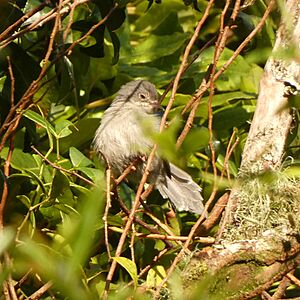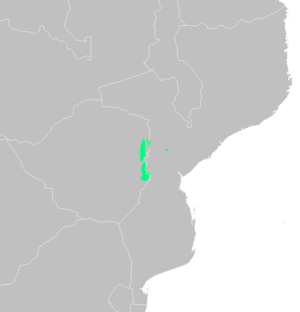Chirinda apalis facts for kids
Quick facts for kids Chirinda apalis |
|
|---|---|
 |
|
| Conservation status | |
| Scientific classification | |
| Genus: |
Apalis
|
| Species: |
chirindensis
|
 |
|
| general range: the montane forest-grassland mosaic | |
The Chirinda apalis (Apalis chirindensis) is a small passerine bird. This means it is a type of perching bird. It belongs to the family called Cisticolidae. This bird lives only in the Eastern Highlands of Zimbabwe and Mozambique. You can find it in warm, wet forests, especially in the mountains.
Contents
About the Chirinda Apalis
The Chirinda apalis was first officially described in 1906. This was done by an English bird expert named George Ernest Shelley. He found the first example of this bird in the Chirinda Forest in Zimbabwe.
What Does it Look Like?
The Chirinda apalis has a slim body and a long tail. It also has a thin beak. Its feathers are mostly dull grey. They are darker on its back and lighter on its belly. Its tail feathers have white tips.
Both male and female birds look quite similar. However, females often have a paler beak base. Young birds look like adults but might have a bit more yellow or green in their feathers. They also have a paler beak. These birds are usually about 11 to 13 centimeters long.
What Does it Sound Like?
The Chirinda apalis makes a repeated "chip" sound. People have described its call as "chpip-chipip" or "swick-swick-swick".
Where Does it Live?
The Chirinda apalis is found only in southeastern Africa. It lives in the Eastern Highlands of Zimbabwe and Mozambique. You can also find a small group on Mount Gorongosa in Mozambique.
These birds live in evergreen forests. They also like dense bushes near rivers. They usually live at high altitudes, between 1,200 and 2,200 meters above sea level. Sometimes, they move to lower areas during the winter.
What Does it Eat?
The Chirinda apalis mostly eats insects. Its favorite foods include beetles, caterpillars, and flies. These birds often join groups of other birds that eat insects. They travel through the forest together, looking for food on leaves and branches.
How Do They Raise Their Young?
Chirinda apalis birds lay their eggs in spring and summer. This happens from October to February. They build a dome-shaped nest using leaves, moss, and fern pieces. The nest has an entrance on the side and a fake entrance on top. They usually place their nest on a small, mossy branch, about 20 meters above the ground.
Why is it Important to Protect Them?
The Chirinda apalis is listed as a Vulnerable species. This means its population has been decreasing quickly. The biggest threat to these birds is the loss of their habitat. Forests where they live are being cut down or damaged. In the last 10 years, about 35% of the tree cover in their home range has been lost. Protecting these forests is very important for the Chirinda apalis to survive.


